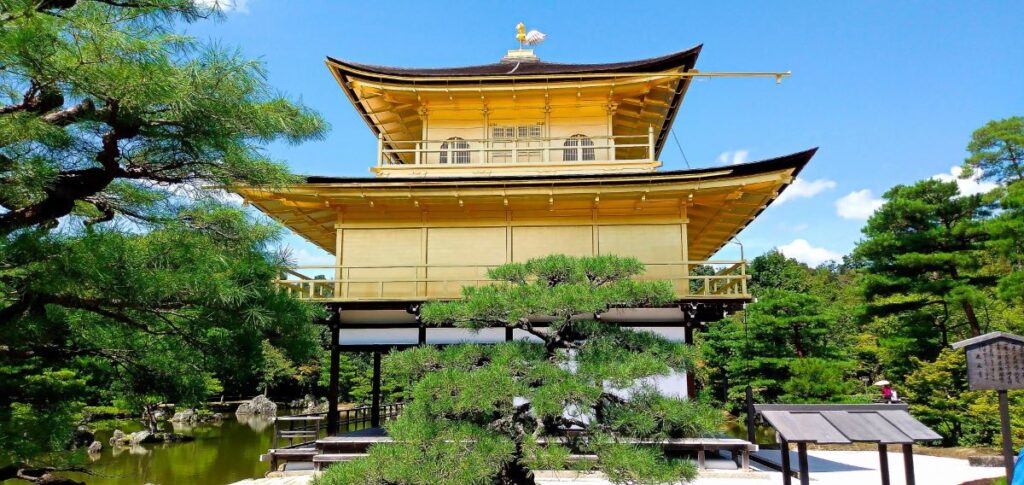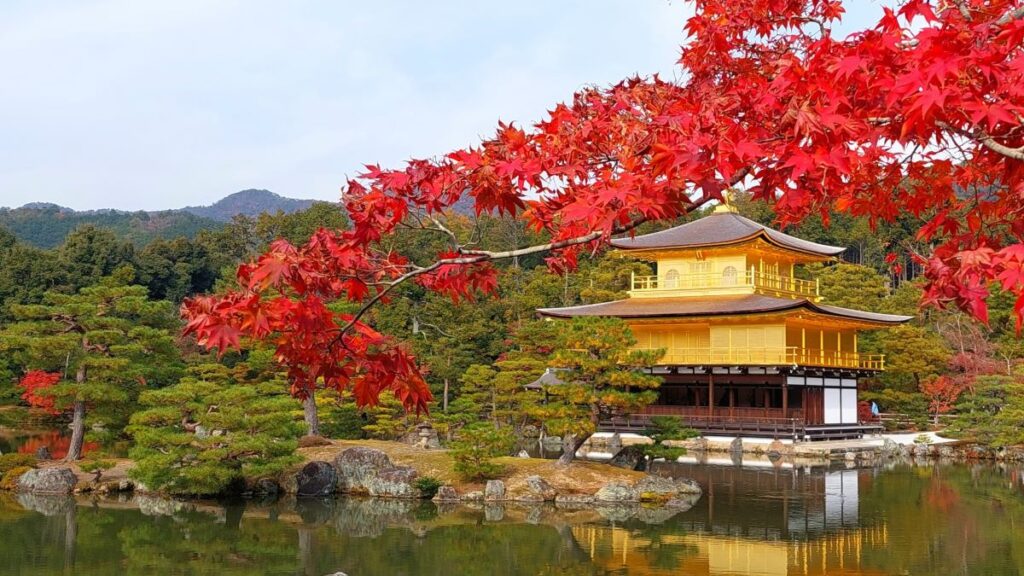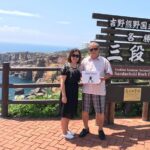Kinkakuji, also known as the Temple of the Golden Pavilion, is a Zen Buddhist temple located in the northern part of Kyoto, Japan. It is one of the most popular tourist attractions in Kyoto, attracting millions of visitors each year. The temple is known for its stunning architecture and beautiful gardens, and it has been designated as a UNESCO World Heritage site.
The temple was originally built in the 14th century as a retirement villa for a shogun, but it was later converted into a temple by his son.

The current structure is a reconstruction of the original temple, which was destroyed by fire in 1950. The temple is famous for its golden pavilion, which is covered in gold leaf and reflects beautifully in the pond that surrounds it.
On a trip to Kinkakuji can explore the temple grounds, which include several other buildings and beautiful gardens. The gardens are designed to be viewed from different angles, and we love to enjoy different perspectives of the temple and its surroundings as they walk through the grounds.
The temple is particularly beautiful in the autumn when the leaves change color and the gardens are ablaze with reds, oranges, and yellows.
History Of Kinkakuji

Kinkakuji, also known as the Golden Pavilion, is a Zen Buddhist temple located in Kyoto, Japan. The temple was originally built in 1397 as a villa for shogun Ashikaga Yoshimitsu. After his death, the villa was converted into a temple according to his wishes.
The temple has a long and storied history, having been destroyed and rebuilt several times over the centuries. The most famous incident occurred in 1950, when a young monk set fire to the temple, destroying the top two floors. The temple was later rebuilt, and the new pavilion was covered in gold leaf, just like the original.
Despite its tumultuous history, Kinkakuji remains one of the most popular tourist attractions in Japan, drawing visitors from all over the world. The temple’s stunning architecture and beautiful gardens are a testament to the skill and craftsmanship of the artisans who built it.
Today, Kinkakuji is a UNESCO World Heritage site and is considered one of the most important cultural landmarks in Japan. It is a symbol of the country’s rich history and culture, and a must-see destination for anyone visiting Kyoto.
The temple was originally named Rokuon-ji, or “Deer Garden Temple,” and was later renamed Kinkakuji, or “Temple of the Golden Pavilion,” after the pavilion was covered in gold leaf.
Architecture

The Kinkakuji Temple is a stunning example of Japanese architecture from the Muromachi period. The temple’s main building, the Golden Pavilion, is a three-story structure with the top two floors covered in gold leaf. The first floor is built in the shinden-zukuri style, which was popular during the Heian period. The second floor is built in the buke-zukuri style, which was used for samurai residences. The third floor is built in the Chinese Zen style, which was popular during the Muromachi period.
The Golden Pavilion is surrounded by a beautiful garden that is designed to reflect the changing seasons. The garden includes a pond, various rock formations, and carefully placed trees and shrubs. The garden is a perfect example of the Japanese concept of wabi-sabi, which emphasizes simplicity, natural beauty, and imperfection.
The pavilion’s architecture incorporates three distinct styles, which are shinden, samurai, and zen, specifically on each floor. The first floor is designed in the shinden-zukuri style, which is characterized by a raised floor, a hipped roof, and a veranda. The second floor is designed in the buke-zukuri style, which is characterized by a gabled roof and a smaller veranda. The third floor is designed in the Chinese Zen style, which is characterized by a steeply sloping roof and no veranda.
The Golden Pavilion has been designated as a National Special Historic Site and a National Special Landscape, and it is also a UNESCO World Heritage Site. Visitors are allowed to view the pavilion from across the pond, but they are not allowed to enter the building.
The temple grounds also include several other buildings, including a tea house and a hall that houses a statue of the Shaka Buddha. Visitors can also explore the temple’s gardens and the surrounding forested hills.
Garden

Kinkakuji’s garden is an essential part of the temple’s beauty and tranquility. The garden is a classic example of a Japanese strolling garden of the Muromachi period, designed to be a paradise garden in which to stroll and meditate, remembering that Buddha had lived and preached in a grove. The garden has symbolic elements, including the pond, rocks, and plants, which represent mountains and islands.
The garden is meticulously maintained and features a variety of trees, including cherry, maple, and pine, which provide a stunning backdrop in every season. The pond is home to several species of fish, including koi, which are a symbol of good fortune in Japanese culture. Visitors can enjoy the garden’s natural beauty while strolling along the path that leads around the pond, offering great viewing axes and stunning vistas.
One of the most iconic features of the garden is the reflection of the Golden Pavilion in the pond. The reflection creates a breathtaking view that is especially beautiful during autumn when the leaves change color. The garden also features several teahouses, including Sekka-tei, which is open to the public and offers a unique view of the garden from its veranda.
The view changes depending on the time of year, including cherry blossom viewing in spring and autumn foliage viewing in fall. The garden is open year-round, and each season offers a unique experience.

Kinkakuji’s garden is an extraordinary example of a Japanese strolling garden of the Muromachi period. The garden’s design is meant to be a reflection of the natural landscape and is intended to create a sense of harmony and balance between the built environment and nature. The garden’s beauty and tranquility make it a must-see destination for visitors to Kyoto.
Visiting Kinkakuji

Kinkakuji, also known as the Golden Pavilion, is one of the most popular tourist attractions in Kyoto. It is a Zen temple that is famous for its stunning architecture and beautiful gardens. Visitors can expect to spend at least an hour exploring the temple grounds and taking in the breathtaking views.
When visiting Kinkakuji, it is important to dress appropriately. Visitors should wear clothing that covers their shoulders and knees out of respect for the temple’s religious significance.
You should be prepared for crowds, especially during peak tourist season.
Upon entering the temple grounds, visitors will see the stunning Golden Pavilion. The pavilion is covered in gold leaf and is surrounded by a tranquil pond and beautiful gardens. Visitors can take a walk around the pond and enjoy the scenery or take a closer look at the pavilion from various viewpoints.
After viewing the Golden Pavilion, visitors can explore the rest of the temple grounds. There are several other buildings and gardens to see, including the Anmintaku Pond Garden and the Sekkatei Teahouse. Visitors can also take a stroll through the forested area surrounding the temple.
Note that visitors cannot enter the Golden Pavilion. However, they can still admire it from the outside and take photos. Visitors should also be respectful of the temple’s rules and regulations, such as not smoking or littering on the temple grounds.
Overall, visiting Kinkakuji is a must-do activity for anyone traveling to Kyoto. With its stunning architecture, beautiful gardens, and peaceful atmosphere, it is a truly unforgettable experience.
Facts and Trivia
Kinkakuji, also known as the Golden Pavilion, is a Zen Buddhist temple located in Kyoto, Japan. Here are some interesting facts and trivia about this iconic temple:
- The temple was originally built in 1397 as a retirement villa for the shogun Ashikaga Yoshimitsu. After his death, it was converted into a temple according to his wishes.
- The top two floors of the temple are covered in gold leaf, which is where it gets its nickname, the Golden Pavilion.
- The Golden Pavilion is not the only building on the temple grounds. There are several other buildings, including a tea house and a pond garden.
- The temple has been destroyed and rebuilt several times throughout its history. The current structure dates back to 1955.
- Kinkakuji is a UNESCO World Heritage site and is considered one of the most popular tourist attractions in Japan.
In addition to its beauty and historical significance, Kinkakuji has also been the subject of some interesting stories and legends:
- According to legend, the original owner of the villa, Ashikaga Yoshimitsu, was so fond of the Golden Pavilion that he would often spend hours gazing at his reflection in the gold leaf. It is said that after his death, the pavilion was turned into a temple in order to prevent anyone else from becoming as obsessed with it as he was.
- During World War II, a young monk set fire to the temple in an act of arson. The temple was destroyed, but the Golden Pavilion miraculously survived the fire. The monk was later arrested and executed for his crime.
- The temple has also been featured in several works of fiction, including the novel “The Temple of the Golden Pavilion” by Yukio Mishima.
Overall, Kinkakuji is a fascinating and beautiful place with a rich history and many interesting stories attached to it and is a beloved and iconic part of Kyoto’s esence.





